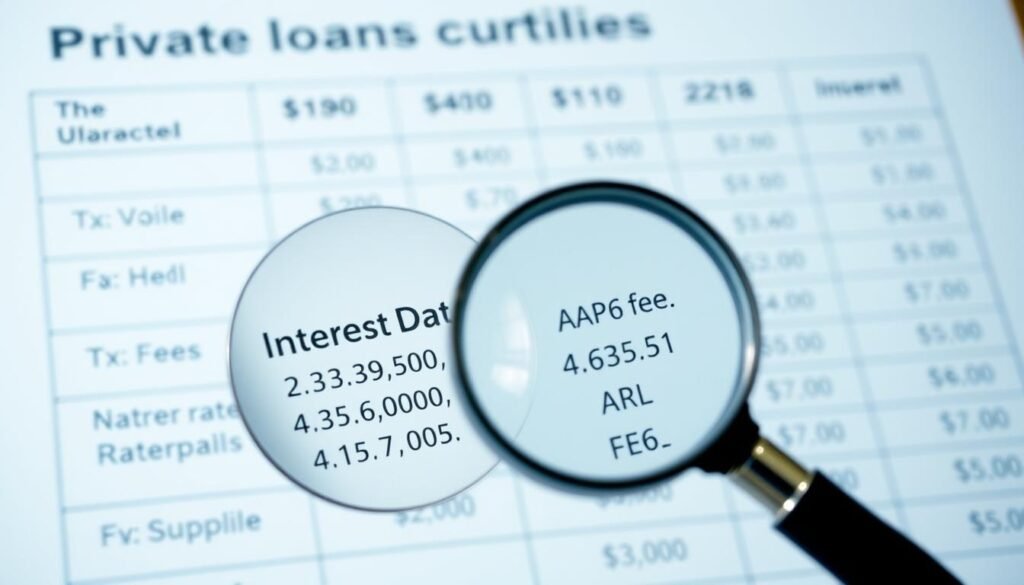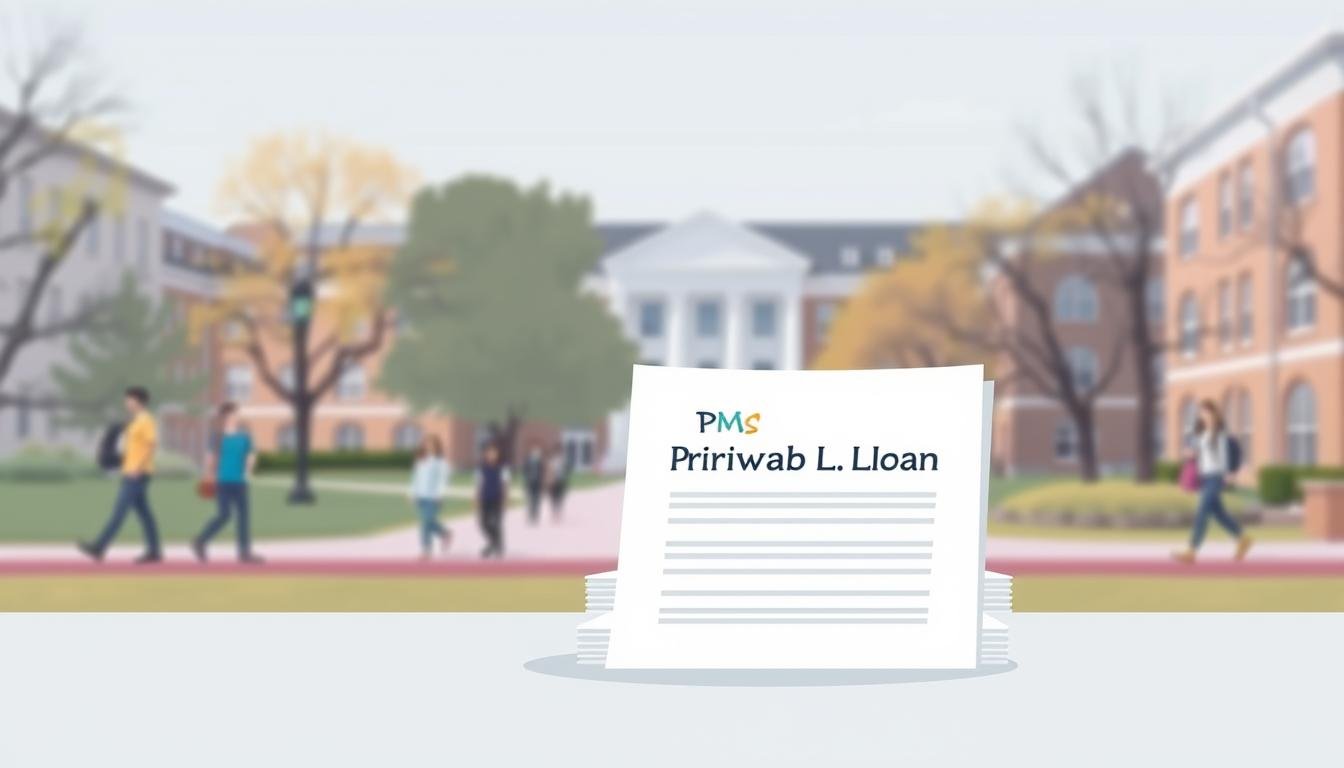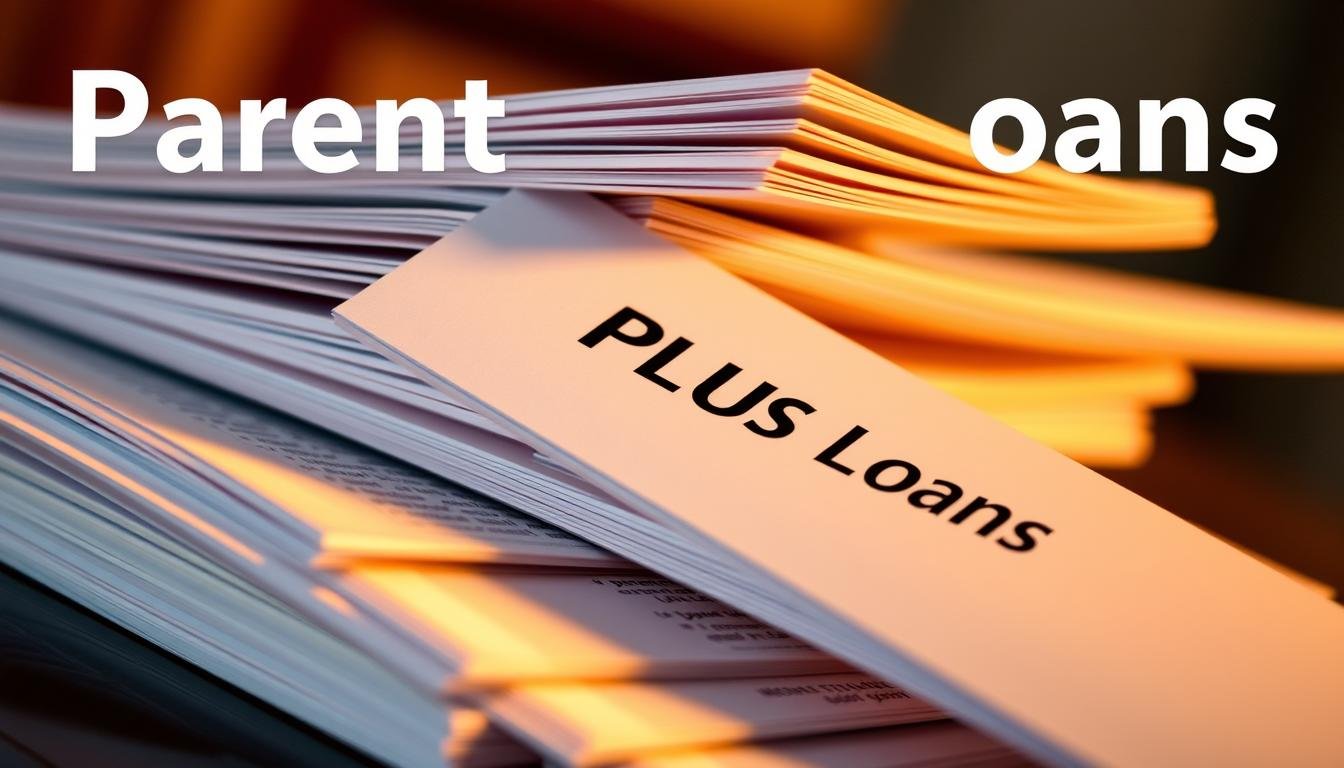Private student loans fill gaps when federal aid and scholarships do not cover a school’s full cost. They are offered by banks, credit unions, and specialty lenders to cover tuition, fees, housing, and related education expenses.
Borrowers are encouraged to exhaust federal options first because federal choices often offer lower interest rates and stronger protections. Many lenders will certify up to 100% of school-approved costs and let funds disburse to the college each term, with any extra refunded for qualified expenses.
Repayment options vary: deferred while enrolled, interest-only, small fixed payments, or immediate repayment. Rates and approval depend on credit and may improve with a creditworthy cosigner. Marketplaces like Credible let students compare prequalified offers without a hard credit pull so they can estimate monthly payments and long-term cost before borrowing.
Key Takeaways
- Private student loans close gaps after financial aid and scholarships are applied.
- Federal options often have better rates and protections; check them first.
- Lenders may cover full school-certified costs and disburse funds to the school.
- Rates can be fixed or variable and hinge on credit and cosigner status.
- Repayment choices affect total interest; in-school deferment raises long-term cost.
- Use marketplaces and calculators to compare offers and estimate true cost.
Beginner’s Overview: Private Student Loans in the United States
Beyond federal student programs, banks and credit unions offer targeted funds to help cover campus expenses. Private student loans serve as a supplement when grants, scholarships, and federal student loans leave a gap.
These loans originate at financial institutions and usually require school certification. The school confirms the cost of attendance and the lender sends disbursements to the campus. Any refundable excess typically goes back to the borrower for qualified expenses.
Application steps differ from federal loans. Federal loans come through FAFSA, while lender applications include credit reviews and possible cosigner requests.
- Use case: Fill a precise funding gap after other financial aid.
- Timing: Match requests to billing cycles and award deadlines.
- Cost factors: Interest and rates vary by credit profile and term.
Students should weigh long‑term plans, projected income, and monthly budgets before choosing any loan product for college education.
What Is Private Loans: Definition, Scope, and When They’re Used

When grants and scholarships leave a balance, credit-based education financing often fills the shortfall. A private student loan serves as a supplement, not a replacement for federal aid. Students should seek federal options first, then top up with a private student loan only for the needed amount.
How these loans fill the gap after aid
Private student loans typically step in after grants, scholarships, work-study, and federal student loans are applied to the account. Lenders usually cap borrowing at the institution’s cost of attendance minus aid, so the annual maximum mirrors tuition, fees, housing, and related budget items.
School‑certified vs direct‑to‑consumer
School‑certified options require the school to confirm eligibility and receive disbursements. That pathway can mean lower pricing but slower processing. Direct‑to‑consumer products send funds faster to the student and may carry higher rate and over‑borrowing risk.
Disbursement, refunds, and cost timing
Lenders disburse to the school by term. If borrowed funds exceed billed charges, the campus issues a refund to the borrower for books and other qualified expenses. Interest accrues during deferment, and a variable interest choice can change the rate over time. Borrowers should confirm billing calendars and use calculators to compare offers before accepting any loan.
Private Student Loans vs Federal Student Loans

Comparing government-issued student financing with bank-originated products helps borrowers weigh cost and protections. The contrast centers on rates, repayment options, and legal safeguards.
Interest, variable interest, and subsidies compared
Federal student loans often feature fixed rates set annually and, for subsidized types, the government may pay interest while a student attends school. By contrast, many private student options accrue interest immediately, and variable interest can rise if market benchmarks move.
Eligibility, borrower protections, and bankruptcy differences
Eligibility for federal programs relies on FAFSA and enrollment. Private approval depends on credit, income, and sometimes a cosigner.
- Protections: Federal loans offer income‑driven repayment, deferment, and standardized forbearance rules.
- Private terms: Lender policies vary; some allow forbearance or cosigner release but conditions differ widely.
- Bankruptcy: Student loans of either type are rarely dischargeable except for undue hardship.
Tip: Compare total cost and protections side by side with calculators before borrowing.
Interest Rates, APR, and Fees: Understanding the Real Cost

Interest benchmarks and origination charges often explain why two offers with similar numbers cost very different amounts.
Fixed vs variable structures
Fixed interest rate gives predictable monthly payments. A variable option ties the rate to benchmarks such as SOFR or Prime. Variable rates can fall or rise, changing total interest paid over the term.
Quoted rate vs APR
APR combines interest and fees into a single figure. Comparing APRs only works when repayment terms match, since longer terms can lower APR but raise lifetime cost.
Fees and origination
Some lenders charge origination fees while others advertise zero fees. Fees can add materially to cost — a 3–4% fee often behaves like roughly a 1% higher interest rate over the life of the loan.
- Loans usually accrue interest while the student attends school; interest-only payments can cut capitalization.
- Auto-debit discounts, credit tiers, and term length all shift final pricing.
- Use a comparison calculator and list offers side by side to weigh rate, APR, fees, and repayment terms.
Eligibility, Credit Score, and Cosigners

The approval path for a private student loan often starts with a quick review of credit and income. A lender groups applicants into 4–6 credit tiers. Better credit profiles receive lower rates and stronger terms.
Credit tiers, lower interest rates, and cosigner impact
Credit score drives pricing. Many undergrad requests need a creditworthy cosigner — more than 90% do. For grads, over 75% often add one. Adding a cosigner can improve approval odds and reduce the rate.
Other requirements
Eligibility usually includes attending an accredited school, U.S. citizenship or permanent residency, and minimum half‑time enrollment. Lenders also check debt‑to‑income and academic progress.
- Soft‑pull prequalification is common so students can compare rates without harming credit.
- Some lenders offer cosigner release after a string of on‑time payments and a credit reassessment.
- Federal student programs rarely require a cosigner; private paths rely more on credit and income.
| Credit Tier | Typical APR Range | Cosigner Likely? |
|---|---|---|
| Top tier | 4%–8% | No |
| Mid tier | 8%–12% | Sometimes |
| Lower tier | 12%–18%+ | Usually |
Tip: Check your credit, fix errors, and borrow only what the school certifies to avoid delays and higher cost.
Repayment Terms and Options for Students and Graduate Students

Repayment choices shape monthly obligations and lifetime cost. Borrowers can choose immediate repayment, interest‑only, small fixed payments (for example, $25), or full deferment until after school.
In‑school and early repayment options
Interest‑only or flat small payments reduce interest capitalization and ease later payments. Full deferment keeps payments paused but lets interest accrue and compound, raising total cost.
Grace, forbearance, and term lengths
Grace periods vary; some lenders offer up to nine months after graduation, while many set terms from 5 to 20 years. Forbearance and hardship help differ from federal programs and are usually shorter or more limited.
- Effect on cost: Deferred repayment raises accrued interest; paying interest during school lowers lifetime interest.
- Graduate students: Some lenders offer extended grace or tailored timelines for professional degrees.
- Servicer perks: Auto‑debit discounts (about 0.25%) can lower rates and monthly payments.
| Option | Typical Impact | Who it suits |
|---|---|---|
| Immediate full repayment | Lowest lifetime interest; highest current payments | Students with steady income |
| Interest‑only in school | Controls capitalization; moderate payments | Those wanting lower future bills |
| Flat $25 payments | Small cash‑flow relief; reduces interest growth | Budget‑conscious borrowers |
| Deferred until after school | Lowest short‑term burden; highest lifetime cost | Those with no current income |
Tip: Model several repayment scenarios — vary terms and rates — to pick manageable payments without excess cost. Review servicer policies on forbearance, deferment for further study, and cosigner release before signing any loan.
How to Choose a Private Lender and Compare Options
Choosing the right lender matters more than chasing the lowest advertised number. Use a structured comparison to match the amount and term to monthly budget and future plans.
Using marketplaces and lender snapshots
Marketplaces like Credible let applicants and cosigners complete one form to see prequalified offers without a hard credit pull. That reveals realistic rates and helps avoid teaser pricing.
Quick lender features to scan
- Sallie Mae: school‑certified undergrad and graduate options, interest‑only or $25 payments, 0.25% auto‑debit discount, no origination fee.
- Ascent: cosigned and non‑cosigned paths, autopay discount up to 1%, 1% cash‑back graduation reward, terms 5–20 years, no fees.
- College Ave: fast decisions, multiple repayment options, terms of 5–15 years, no fees.
- ELFI: advisor support, parent loan options, terms 5–15 years, no fees.
Red flags and a simple checklist
Watch for teaser rates that only apply to top credit tiers, hidden fees, and preferred‑lender placement that may reflect lender compensation. Check cosigner release timelines, hardship options, and support quality.
| Provider | Typical rate range | Terms (years) | Fees / Perks |
|---|---|---|---|
| Sallie Mae | Mid–low for strong credit | 10–15 | No origination fee; 0.25% autopay |
| Ascent | Wide by credit tier | 5–20 | No fees; up to 1% autopay; graduation cash back |
| College Ave | Competitive by tier | 5,8,10,15 | No fees; fast approval |
| ELFI | Tailored pricing | 5,7,10,15 | No fees; advisor support; parent loans |
Checklist: save prequalified offers side‑by‑side: rate, APR, fees, term, borrower perks, cosigner rules, and customer support. Compare before signing to find the best fit for the student’s budget and credit profile.
Application Process and Timeline
Begin by mapping needed funds against the school billing calendar to plan a clear timeline. Start this step after financial aid award letters arrive so the student borrows only the shortfall.
Prequalify and gather documents
Use soft‑pull prequalification to view estimated rates without harming a credit score. Gather ID, income proof, and school cost statements before starting any application.
Apply with multiple lenders
Apply to 3–5 lenders within a short time window to compare offers on rate, APR, term, and perks. Many lenders give instant or same‑day decisions online.
School certification and disbursement
The school certifies the approved amount against the cost of attendance. After certification, the lender schedules disbursement to campus by the term due date. Any excess funds may be refunded to the borrowers for books or living costs.
- Research lenders and prequalify to lock realistic offers.
- Compare draft payment schedules before signing the promissory note.
- Keep written records of communications with the school and lender.
| Step | Typical time | Result |
|---|---|---|
| Prequalification | Minutes–hours | Estimated offers without hard credit pull |
| Full application | Minutes–days | Conditional approval; documents verified |
| Certification & disbursement | Days–weeks | Funds sent to school; refunds to student if applicable |
Responsible Borrowing Tips and Risk Considerations
Smart borrowing begins with a clear plan that links future income to monthly payments. Students should exhaust savings, grants, scholarships, and federal student loans before seeking additional funds.
Borrow only the amount needed
Keep the borrowed sum to school‑certified costs. Overborrowing raises pressure after graduation and increases total interest.
Model payments and watch rate changes
Use online calculators to compare terms. Remember that variable APRs mean rates may adjust and monthly bills can rise.
- Compare identical terms: Match repayment length when assessing APR to avoid misleading comparisons.
- Seek lower interest rates: Strong credit, steady income, or a cosigner often yields lower interest offers.
- Review lender conditions: Check cosigner release, hardship policies, and rules if a cosigner dies or declares bankruptcy.
- Make interest payments in school: Paying interest while enrolled limits capitalization and lowers lifetime cost.
- Keep an emergency fund: A small reserve reduces default risk after leaving college.
Before signing any application, read disclosures on rate adjustment mechanics, fees, and servicing practices. Reassess the need for borrowing each year and if enrollment or college plans change.
Conclusion
Students and families should treat additional lender options as tools to finish the budget, not to expand it. Private student loans can close gaps after scholarships, aid, and federal student loans have been used.
Compare interest rate choices, balancing fixed versus variable interest so rates may not surprise later. Check APR, fees, and term length together, since loans usually accrue interest in school and capitalization raises balances.
Prequalify to view personalized offers, verify credit score, and compare lenders like Sallie Mae or marketplaces for faster side‑by‑side comparison. A small, strong, repayment plan helps set realistic payments and avoid overborrowing.
Confirm school certification and disbursement timelines, document the amount needed each term, and save records of refunds. Graduate borrowers should seek specialized options but still weigh protections and total cost.
Read conditions and disclosures on cosigner, hardship, and forbearance before signing. Responsible choices protect credit and keep education financing aligned with long‑term financial health.






